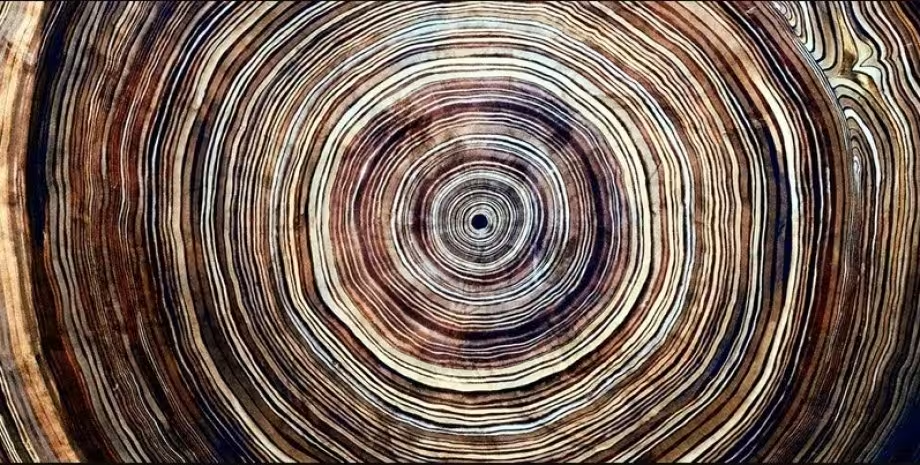Harsh space weather could leave a permanent mark on tree rings, offering clues that could help scientists prepare for future catastrophic events that threaten communications satellites and astronauts. Amy Hessl, a professor of geography at West Virginia University’s Eberly College of Arts and Sciences, leads research examining how ancient tree rings record evidence of extreme space weather, such as geomagnetic storms and bursts of solar radiation.
Tracking space weather through tree rings
Space weather involves a range of events, such as geomagnetic storms that cause auroras near the poles. These events can sometimes be so intense that they disrupt modern technology. According to Hessl, ancient tree rings are evidence of such extreme events in the distant past.
“If one of these events were to happen today and you were on a high-latitude flight to Norway, you would probably get the radiation dose on board,” Hessl explained. “And if you were in space, it could potentially kill you.”
Hessl recently received more than $202,000 in funding from the National Science Foundation to further investigate the connection between tree rings and space weather. Their research focuses on how particles from the sun interact with Earth’s atmosphere to produce radiocarbon that is absorbed by trees.
As trees grow, they use carbon from the atmosphere to build their rings, effectively preserving a record of past solar activity. By analyzing these tree rings, researchers can track important events such as rare and violent “Miyake events.”
Extreme solar storms caught in trees
Miyake events are characterized by rapid increases in the amount of radioactive carbon in the atmosphere and have been detected in tree rings dating back centuries. The first of these events, which took place between 774 and 993 AD, was detected 12 years ago. Since then, scientists have discovered seven more events in the last 14,000 years. “Some of these events were really extreme and could be incredibly damaging to our telecommunications system right now,” Hessl said. “This is a very rare event but it’s not being ignored. We depend on satellites and if this were to happen again it would probably take out most of our telecommunications and take 15 years to recover. It’s that powerful.”
While most solar energetic particles originate from solar flares, some particles also originate from galactic cosmic rays outside the Solar System, usually caused by supernova explosions. Although the primary source of Miyake events is believed to be the sun, Hessl hopes that tree ring data from around the world can help the scientific community determine the exact causes of these events and assess their severity.
Interpreting tree ring data
Radiocarbon levels in tree rings are not always easy to interpret. “Until recently, scientists assumed that trees absorbed radioactive carbon equally,” Hessl said. he said. “We treated trees as scientific tools. But they’re not. They’re potentially quite biased in how they detect radiocarbon.”
To improve the accuracy of the data, Hessl and his team are investigating why different tree species or trees in different locations might absorb radiocarbon differently. Understanding these differences could help scientists better evaluate how reliable these natural recording devices are.
Miyake’s case study also shows that some trees store and then distribute carbon, making them less consistent as recorders of past atmospheric conditions. To resolve these inconsistencies, Hessl collaborated with Maria Carbone of Northern Arizona University and Rachel Filvett of Montana State University.
Together, they examine how different tree species record radioactive carbon in the atmosphere each year, focusing on three sites in the United States where wood remains from the last three major Miyake events.
Comparing tree species for consistency
Hessl’s team compared three species with different wood production strategies: perennial bristlecone pine from Utah, deciduous bald cypress from North Carolina, and preserved oaks in Missouri riverbeds. Scots pine, the world’s longest-lived tree species, has been particularly important in establishing the chronology of past radiocarbon levels. “They live for several thousand years and form the basis of what we know about past radiocarbons in the atmosphere,” Hessl explained.
The research involves taking pencil-sized core samples (or sections if the tree is dead) and using a technique called cross-dating to confirm the year each ring formed. By matching tree rings to known Miyake events, the team can investigate how different species record these extreme events. But Hessl thinks different trees may capture the details of these sections in different ways. Preparing for future space weather events
The purpose of this study is to better understand the magnitude and timing of past space weather events and to evaluate the reliability of trees as atmospheric radiocarbon recorders.
“We are trying to determine how extreme these events are,” Hessl said. “When exactly did they happen? How long did the radiocarbon stay in the atmosphere? We have to make sure we use reliable record companies, so that’s what we’re trying to understand.”
By studying how different trees record past events and how they respond to radiocarbon changes today, Hessl hopes to prepare for potential future space weather events that could threaten critical infrastructure, including communications networks.
Rare extreme solar storms
Although Miyake’s incident is considered rare and unlikely, Hessl emphasizes the importance of preparation.
“Some things are a bit exaggerated, but we saw what happened during the pandemic in terms of the initial panic,” he said. “So it’s really smart to try to find the positive aspects of these things and then communicate that to the IT community so we can ensure our technology is protected.”
Ultimately, Hässl’s work on tree rings and their ability to record harsh space weather opens a window into understanding rare but potentially catastrophic solar events. By looking back, scientists hope to better prepare for the future by ensuring that today’s technologies are more resilient to the powerful forces of space weather.
Source: Port Altele
